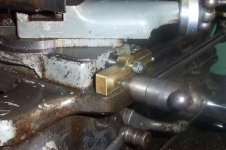My brother saw the automatic stops on one of my lathes today and mentioned them, I said I'd never used them, and doubted that most machinists do.
This made me wonder if I'm right. Am I missing manual lathe Valhalla? One of my lathes even came with cross slide stops, which I promptly took off as the mechanism was in the way.
Time was, labour was cheaper, CNC had not arrived, some work didn't fit a little Hardinge, nor a firm own a Gisholt, Warner & Swasey, etc - and ordinary manual engine lathes, even "toolroom" lathes were actually used for unit production in significant volume.
Stops - GOOD ones - were essential for that. A "setup man" or team leader would do the arranging and test it to insure parts hit spec, and towards the edge of the range that allowed for a bit of tool wear.
A bored housewife at min-wage might then make the parts for several hours, periodic QC indicate when the tools and setup needed attention. Skilled setup man was off working-up another one in the meanwhile. If anybody sat unproductive for a spell, it was the lesser-skilled and lower-wage person.
Common as all get-out back in the day.
G'Mum, not even five feet tall, ran a big old capstan lathe to put the pointy ends on War One Royal Navy artillery projectiles. Proud as punch about it, too!



